You are welcome to join me on this fifteenth of a series of articles taking a look back over my shoulder at some sightings that have not only delighted us but startled and surprised us. Members who have been around Birdforum for a while may have noted that Otters are a big favourite of ours but may have missed the clues that hinted at how much we love Hares too, but we love these landlubbers just as much as otters.
Most of our encounters with Brown Hares Lepus europaeus have been on the Isle of Islay, off the south-west coast of Scotland and most of my observations were made using a combination of Zeiss SFs and the naked eye.
Many years ago we found a pair of leverets there (the term for very young hares) hiding alongside each other, arranged nose to tail, in a big tuft of grasses and rushes. They must have been very recently born as they normally split up as soon as possible. Two leverets together probably creates a bigger scent source that predators could detect and two leverets together could be easier for raptors to see too, so if they move apart as soon as they can it minimises the risk of a predator destroying the whole family in one incident.
We have also seen adult hares boxing there too. These fisticuffs occur when a male approaches a female with intentions to mate and the female is not ready. In these circumstances the female stands up on her back legs and gives the male a slap on the face. This is all very like humans isn't it?
The area around our rental cottage on Islay has a healthy population of hares that come close to the cottage most evenings and early mornings, to graze or shelter from the weather, and groom themselves or doze. These large and beautiful animals are fascinating to see at close range and we observed and photographed them through our large, double-glazed French windows at the rear of our cottage.
From the hares’ viewpoint, quite low to the ground, I would think that the entire French window would be covered by a reflection of the sky, through which they might be able to see us as ghostly images. Mostly they showed no reaction to our presence close to the window (see pic 1) perhaps because their noses could not confirm our presence by detecting our scent, but occasionally they would react and become more alert when we moved (see pic 2).
When they moved slowly during grazing and other similar activities, they appeared to be ungainly, even clumsy, creatures, but my goodness once they brought those huge back legs into use they became transformed into a cross between an Olympic sprinter and a ballet dancer. Their acceleration was such that I never got a chance for a photo of them running, but I did get a shot of one stretching its back legs before rocketing away (see pic 3).
On one afternoon, what looked like an old adult came to shelter under the stone wall adjacent to our cottage, and it dozed with half-closed eyes for a couple of hours then began a bout of intensive grooming that lasted more than an hour. By then the light was fading and it ventured out into the open and began to graze. It was still there when darkness fell and had been there for 5 hours. Now, the really intriguing thing is that on the following afternoon, a slimmer, younger-looking hare followed exactly the same path that the previous day’s individual had taken, and sheltered in exactly the same place, groomed (see pic 4) and dozed in a similar pattern and again stayed for more than 4 hours. We have stayed there often enough to be able to say with confidence that this sheltering/dozing/grooming/grazing spot isn’t some kind of communally favourite place for the local hares, so we wonder if the first individual was a female, and the second was one of her offspring following the scent of its mother, on the basis that where mother goes it must be safe.
Occasionally we were visited by two hares at the same time and usually these would stay near each other so were perhaps siblings (see pic 5). We rarely saw small leverets apart from in the early spring when, in the evening, the youngsters sensed it was a safe time of day, or were given permission by their mother, and these tiny hares, no bigger than a snowball, came racing out of the tufts of grasses and rushes and dashed madly around for perhaps a minute before disappearing into the undergrowth until the following evening. These tiny bundles of manic energy were a delight to see as they ran at high velocity in and out of the tufts of vegetation, seemingly full of the joy of being able to run like a hare should: fast.
I should also mention that for us, there was the added pleasure of seeing these lovely animals against the backdrop of Atlantic (pics 6 & 7) and other nearby islands which created the most wonderful atmosphere and the expectation that almost anything could happen, and it often did.
Lee
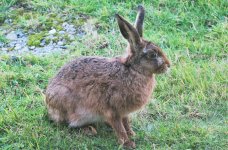
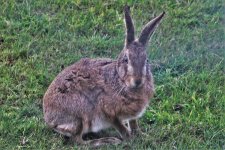
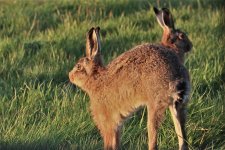
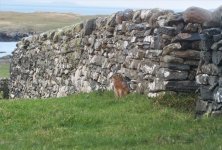
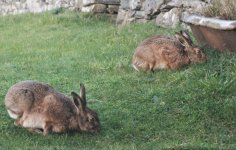
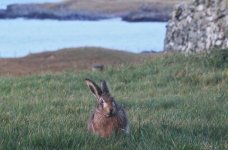
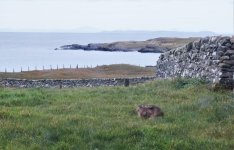
Most of our encounters with Brown Hares Lepus europaeus have been on the Isle of Islay, off the south-west coast of Scotland and most of my observations were made using a combination of Zeiss SFs and the naked eye.
Many years ago we found a pair of leverets there (the term for very young hares) hiding alongside each other, arranged nose to tail, in a big tuft of grasses and rushes. They must have been very recently born as they normally split up as soon as possible. Two leverets together probably creates a bigger scent source that predators could detect and two leverets together could be easier for raptors to see too, so if they move apart as soon as they can it minimises the risk of a predator destroying the whole family in one incident.
We have also seen adult hares boxing there too. These fisticuffs occur when a male approaches a female with intentions to mate and the female is not ready. In these circumstances the female stands up on her back legs and gives the male a slap on the face. This is all very like humans isn't it?
The area around our rental cottage on Islay has a healthy population of hares that come close to the cottage most evenings and early mornings, to graze or shelter from the weather, and groom themselves or doze. These large and beautiful animals are fascinating to see at close range and we observed and photographed them through our large, double-glazed French windows at the rear of our cottage.
From the hares’ viewpoint, quite low to the ground, I would think that the entire French window would be covered by a reflection of the sky, through which they might be able to see us as ghostly images. Mostly they showed no reaction to our presence close to the window (see pic 1) perhaps because their noses could not confirm our presence by detecting our scent, but occasionally they would react and become more alert when we moved (see pic 2).
When they moved slowly during grazing and other similar activities, they appeared to be ungainly, even clumsy, creatures, but my goodness once they brought those huge back legs into use they became transformed into a cross between an Olympic sprinter and a ballet dancer. Their acceleration was such that I never got a chance for a photo of them running, but I did get a shot of one stretching its back legs before rocketing away (see pic 3).
On one afternoon, what looked like an old adult came to shelter under the stone wall adjacent to our cottage, and it dozed with half-closed eyes for a couple of hours then began a bout of intensive grooming that lasted more than an hour. By then the light was fading and it ventured out into the open and began to graze. It was still there when darkness fell and had been there for 5 hours. Now, the really intriguing thing is that on the following afternoon, a slimmer, younger-looking hare followed exactly the same path that the previous day’s individual had taken, and sheltered in exactly the same place, groomed (see pic 4) and dozed in a similar pattern and again stayed for more than 4 hours. We have stayed there often enough to be able to say with confidence that this sheltering/dozing/grooming/grazing spot isn’t some kind of communally favourite place for the local hares, so we wonder if the first individual was a female, and the second was one of her offspring following the scent of its mother, on the basis that where mother goes it must be safe.
Occasionally we were visited by two hares at the same time and usually these would stay near each other so were perhaps siblings (see pic 5). We rarely saw small leverets apart from in the early spring when, in the evening, the youngsters sensed it was a safe time of day, or were given permission by their mother, and these tiny hares, no bigger than a snowball, came racing out of the tufts of grasses and rushes and dashed madly around for perhaps a minute before disappearing into the undergrowth until the following evening. These tiny bundles of manic energy were a delight to see as they ran at high velocity in and out of the tufts of vegetation, seemingly full of the joy of being able to run like a hare should: fast.
I should also mention that for us, there was the added pleasure of seeing these lovely animals against the backdrop of Atlantic (pics 6 & 7) and other nearby islands which created the most wonderful atmosphere and the expectation that almost anything could happen, and it often did.
Lee











